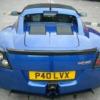
Why Is The 2.2 Engine 'only' 145bhp?
#21

Posted 27 July 2004 - 08:40 AM
#22

Posted 27 July 2004 - 08:55 AM
Edited by JamesGray, 27 July 2004 - 08:56 AM.
#23

Posted 27 July 2004 - 08:57 AM
#24

Posted 27 July 2004 - 09:22 AM
#25

Posted 27 July 2004 - 09:23 AM
#26

Posted 27 July 2004 - 09:40 AM
Edited by WoodenDummy, 27 July 2004 - 09:41 AM.
#27

Posted 27 July 2004 - 09:49 AM
Does that sound about right?
And
Edited by Gedi, 27 July 2004 - 09:52 AM.
#28

Posted 27 July 2004 - 09:52 AM
Dunno why 2.2, but Vauxhall also have 3.2 which is unusual. It must be one of the bigger 4 pots around as 2.5s are normally sixes.2.2 it does seem like a strange number doesn't it.
Not many of them around it's normally a 2.0 or a 2.5.
Why didn't you just go for a SC? You'll get the 225 you looked for and it would still drive like an NA.
Didn't want supercharger as forced induction changes the feel of the car (big lumps of low down torque whereas I wanted a tuned, revvy normally aspirated engine).
I actually think the 2.2 is very good (a lot of the VX 16v are) but won't get the development focus as it is over 2 litres (a typical motorsport threshold)
#29

Posted 27 July 2004 - 09:54 AM
What about VW's 2.9 V6 then. 0.483cc per chamberDunno why 2.2, but Vauxhall also have 3.2 which is unusual. It must be one of the bigger 4 pots around as 2.5s are normally sixes.
heh
#30

Posted 27 July 2004 - 10:08 AM
I said that 2.2 was big for a 4 pot... And you demonstrated a six pot 2.9. Don't understand your point.
And I presume it is actually 0.483 litres per chamber...
The 2.2 is 0.55 litres per cylinder.
There are some bigger ones around but it isn't common. One of the biggest 4's that I know of it the 3 litre in the Porsche 968 with 0.75 litre per chamber.
There are lots of real big V8s with big chambers, but they are hardly revvy...
#31

Posted 27 July 2004 - 10:09 AM
#32

Posted 27 July 2004 - 10:10 AM
#33

Posted 27 July 2004 - 10:44 AM
chill out, I was meerly pointing out the odd size of 2.9 instead of 3.0You what? Have you lost it Gedi?
Oh Gedi, I should also point out that your sig sucks.
inv log (x) is normally written at 10^x
Aren't we in a bad mood today. Its just a joke, your not meant to try solve it. Solving it would obviously not give you a decimal answer, so you can't phone me anyway
#34

Posted 27 July 2004 - 11:07 AM
#35

Posted 27 July 2004 - 11:16 AM
Dunno why 2.2, but Vauxhall also have 3.2 which is unusual.
I seem to recall the reason for the 2.2 was something to do with emissions regulations/economy and retaining said low down torque
It's a pity that the Z22SE wont get the development focus that the C20XE got because of that motorsport threshold
The 2.2 Ecotec....
http://www.gm.com/au...news/press1.htm
There was also one about a the tuning of an Ecotec block to over 1000hp, but I couldn't find it. This is a bit about it though...
http://www.gm.com/co...y/FWDEngine.htm
edit: found it: http://www.year2032.com/ecotec.htm
Edited by caleebra, 27 July 2004 - 11:30 AM.
#36

Posted 27 July 2004 - 11:37 AM
Same hereI would have loved to have the engine and gearbox from my old Civic TypeR in the Speedster. You can make a reliable engine with 100hp/liter, but it's not as cheap as just using a tractor engine like the one Opel used.
I really miss listening to the engine at 8300 rpm before every gearshift.
#37

Posted 27 July 2004 - 11:46 AM
the timing chain with hydraulic tensioner requires no maintenance over its entire working life
hahahahaha...
..hahahahaha...
....hahahah...HAHAHAHAHAHHAHAHAHAHAHHHHHHHHHHHHHHHAHAHAHAHAHAHAHAHHAHAHAHAHAHAHA
HAHAHAHAHHAHAHA
ohgodohgod hahahaHAHAHAHAHAHAHAHAHAHAHAHAHAHAHAHAHHAHAHA.
#38

Posted 27 July 2004 - 11:51 AM
#39

Posted 27 July 2004 - 12:18 PM
I used to run a 6,0 V8 and changed gear at 6500rpm. It was a bit weak below 3500rpm, but I could live with that.There are lots of real big V8s with big chambers, but they are hardly revvy...
I watched a rerun of a NASCAR race yesterday. Their engines are 5,7 or 5,8 liters and they were up at 9600rpm...for 400 miles... Those are pushrod engines of course.
1 user(s) are reading this topic
0 members, 1 guests, 0 anonymous users


















